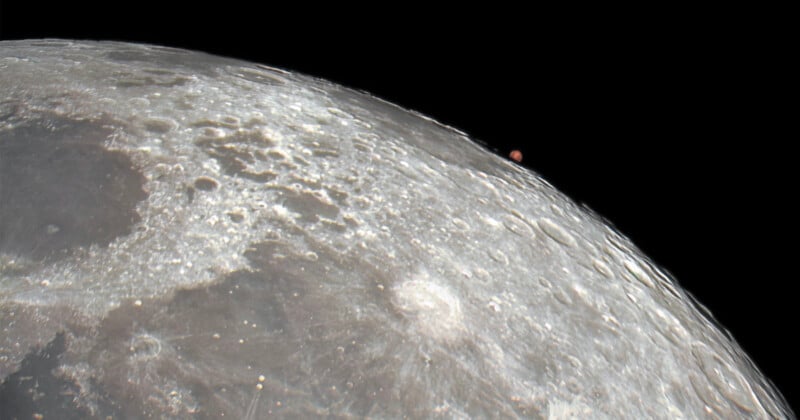Ground Telescope in Arizona Captures Mars Rising Over the Moon

Mars was captured rising above the lunar surface after it was occulted by the Moon on January 13, in a newly-released image.
The Red Planet was captured rising out of the lunar occultation on January 13 by the new Visitor Center 0.6-meter Shreve Telescope at the U.S. National Science Foundation Kitt Peak National Observatory (KPNO), a Program of NSF NOIRLab, near Tucson, Arizona.
“Three days after this photo was taken, Mars was in opposition to the Sun from our point of view on Earth, so coming out of occultation the red planet was almost fully sunlit and appeared brighter and bigger than usual,” writes the NoirLab in a press release.
Although lunar occultations – where the Moon passes directly in front of a planet from our perspective on Earth – happen fairly frequently, it is difficult to see one.
That’s because lunar occultations can only be from a small area of the Earth’s surface. Since the Moon sits so much closer to Earth than Mars, the occultation can only be seen from narrow bands of the planet’s surface. Perspective is everything: the Moon’s apparent position in the sky can shift by up to four times its own width depending on where you’re standing on Earth.
Back in 2022, backyard astrophotographer Andrew McCarthy spent months planning for one. That time it was Mars that appeared over the lunar horizon also.
Two evening visitor guides at the Kitt Peak Visitor Center captured this image using a public-access telescope and free imaging software.

KPNO hosts one of the largest and most varied collections of astronomical instruments in the Northern Hemisphere. Nestled in Arizona’s Quinlan Mountains, within the Schuk Toak District of the Tohono O‘odham Nation, the observatory welcomes visitors daily.
Guests can explore the facilities on guided day and night tours, peer through telescopes, and even book overnight stays to photograph deep-sky wonders beneath some of the clearest, darkest skies in North America.
Image credits: Credit: KPNO / NOIRLab / NSF/ AURA/ J. Winsky & A. Sorensen. Image processing: J. Winsky & M. Zamani (NSF NOIRLab)